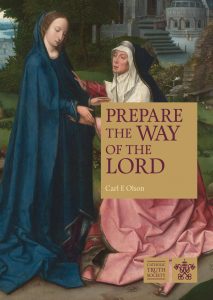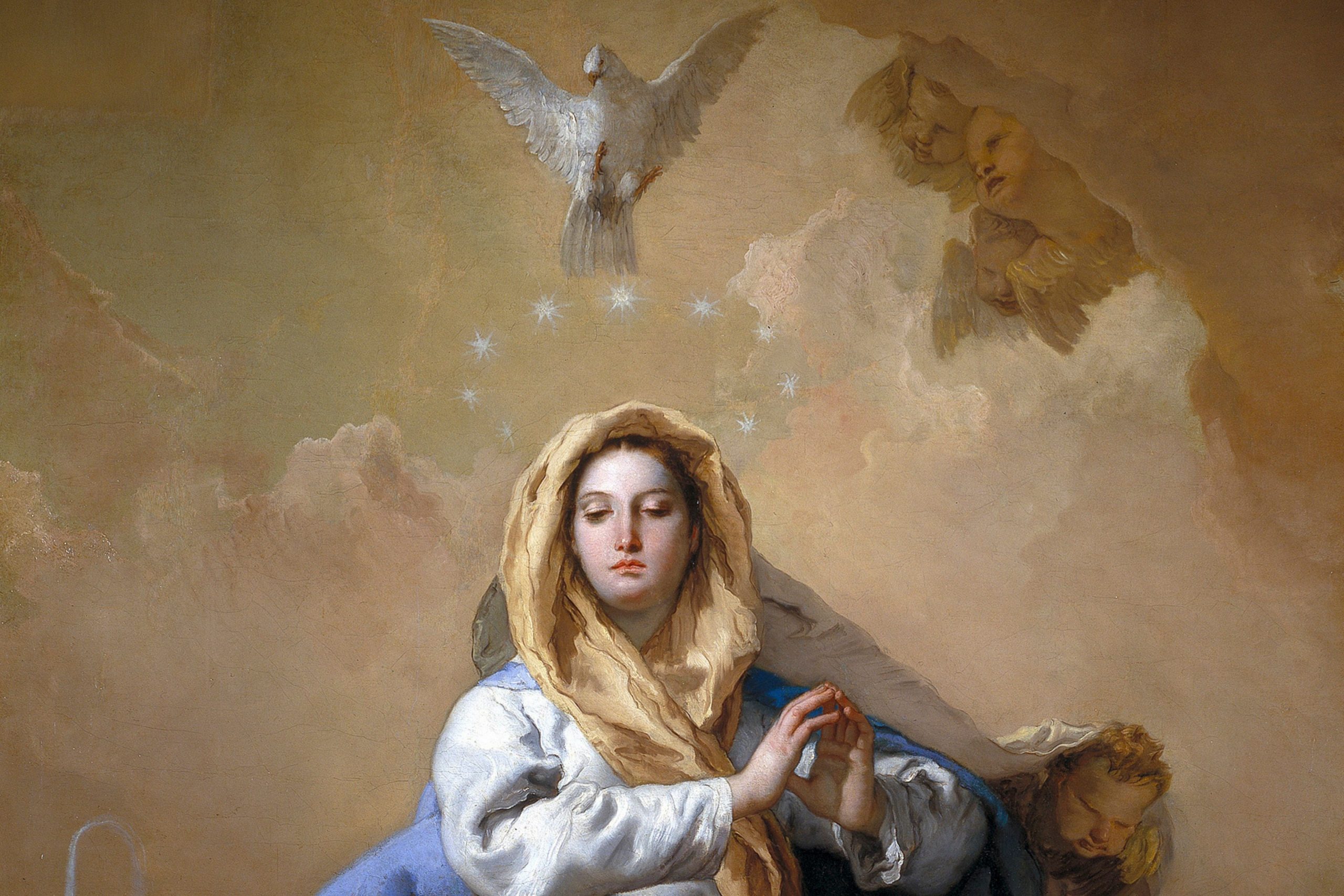Pray for us sinners now and at the hour of our death. Amen.
The final words of the “Hail Mary” are filled with comfort, but also with a reminder of our mortality and the inevitable end to our earthly lives: “Pray for us sinners now and at the hour of our death. Amen.”
This cry to the Blessed Mother might seem distant from – if not at odds with – the season of Advent and the rapidly approaching season of Christmas. What does Advent have to do with sin? What does Christmas have to do with death? Quite a bit, actually. In fact, it is difficult to appreciate Advent and Christmas without squarely facing the dark realities of sin, death and human failing. After all, God became man in order to destroy the power of sin. The eternal Word took on flesh and dwelt among us in order to conquer death. The perfect Son became a slave so that sinful slaves might become perfected, adopted sons.
The Knowledge of the Immaculate Conception
“But,” it might be objected, “what does Mary really know about sin and death? Didn’t she escape both?” It’s true that because she was immaculately conceived – a gift of God’s grace – Mary was saved from sin. But because she is full of grace and in perfect union with her Son, Mary is able to see with utter clarity the human condition and the effect sin has had on the world and on mankind.
She rejoiced in God her Saviour (Lk 1:47) because she knew what sin was, though she remained untouched by its stain. As she stood at the foot of the Cross she experienced the heart-wrenching pain of seeing her Son and Saviour die a death for the sins of the world (cf. Lk 2:35).
So it is fitting and comforting that the Mother of the Son of God prays for her sons and daughters at the hour of their deaths. The Mother of God, from whose faith and body the Redeemer was born, prays that men and women will have the faith to become true children of God, born of the Spirit. The woman who experienced the death of her Son prays that men and women will die to themselves so that they will live in Christ (cf. Ga 2:20).
Some theologians have suggested that the Immaculate Conception was a doctrine meant to awaken the modern world to the fact that human perfection and salvation cannot come from technology, science or ideology, but only from God’s initiative, mercy and grace. Modern man denies that he is a sinner in need of salvation. Contrast that to St Paul, who exclaims that “the saying is trustworthy and deserving of all acceptance, that Christ came into the world to save sinners, of whom I am the foremost.” (1 Tm 1:15).
The true disciple of Jesus Christ must admit his need and his inability to save himself. He is then invited to become a son of God by grace and through divine adoption. This is the incredible reality of deification – man sharing in the freely offered life of God. In the words of St Hilary of Poitiers, “Everything that happened to Christ lets us know that, after the bath of water, the Holy Spirit swoops down upon us from high heaven and that, adopted by the Father’s voice, we become sons of God” (CCC 537).
As the Gospel of Matthew states, Jesus is Emmanuel – “God is with us” (Mt 1:23) – making it possible for man to be with God and have intimate communion with him. And so the promise of Advent culminates in the fulfilment of Christmas.
The Logic of the Assumption
What about the Assumption, the belief that Mary, at the end of her life, was taken up to heaven: How can Mary relate to those whose bodies will become corrupt in the grave? This doctrine has ancient roots in the Church’s Tradition, but many find it puzzling, or even needless.
But the Assumption, seen in the grand picture of salvation history, is a matter of divine logic. Since Mary was sinless and since she bore the perfect Incarnate Son of God, it follows that her body – the tabernacle that bore the God-man – would not suffer the corruption due to sin. She would instead be glorified, just as all those who are filled with grace and who have “put on the Lord Jesus Christ” (Rm 13:14) will one day be glorified.
As theologian John Saward explains:
The Assumption is an application of the Lord’s teaching when he raised Lazarus: “I am the resurrection and the life; whoever believes in me though he die, yet shall he live, and everyone who lives and believes in me shall never die.” (Jn 11:25f) No one lives more truly in Jesus than Mary: he is flesh of her flesh. No one believes in him with greater devotion: “Blessed is she who believed” (Lk 1:45). Thus the Theotokos is not detained by death and passes into glory.
Mary is all about her Son and is always going about his business in heaven as she did on earth.
In his encyclical Redemptoris Mater, Pope John Paul II explains a clear, beautiful truth about the Assumption: “By the mystery of the Assumption into heaven there were definitively accomplished in Mary all the effects of the one mediation of Christ the Redeemer of the world and risen Lord”. And here is the glorious, joyous truth of Advent: “If as Virgin and Mother she is singularly united with him in his first coming, so through her continued collaboration with him she will also be united with him in expectation of the second”.
Mary has experienced every joy and pain imaginable. She clasped in wonder the newborn Christ in her weary arms. She held in sorrow the bloody body of that same Son, grown and violently killed. She stands in heaven and patiently waits for her sons and daughters to come home.
Rejoicing in Salvation
The evangelist Matthew summarises the message of Christmas when he writes, in the first chapter of his Gospel: “For it is through the Holy Spirit that this child has been conceived in her. She will bear a son and you are to name him Jesus, because he will save his people from their sins.” The Lord has come, is coming, and will come again. Advent anticipates, Christmas culminates, and man rejoices: “Glory to God in the highest, and on earth peace among those with whom he is pleased” (Lk 2:14).
A Christmas Confession
Commenting upon the final words of the “Hail Mary”, the Catechism reflects:
We give ourselves over to her now, in the Today of our lives. And our trust broadens further, already at the present moment, to surrender “the hour of our death” wholly to her care. May she be there as she was at her son’s death on the Cross. May she welcome us as our mother at the hour of our passing to lead us to her son, Jesus, in paradise. (CCC 2676)
No one knows the hour of their death. But it will come, just as Christ will come. Both are good reasons to examine our consciences and to go to Confession before Christmas. Even if we have many years left to live, Advent is the time to die: to ourselves, our pride, our selfishness and our fears. Jesus wants to come and fill our hearts completely with his light and life. As children of God, we are “partakers of the divine nature” (2 P 1:4) – if we are in a state of grace. “The soul of the deified person is a spiritual Bethlehem,” writes Saward:
a house of the Bread of Life, a cave that shines with the light of “God’s and Mary’s Son” newborn… The fulfilment of our deification is in the eternal Christmas of heaven, when we hope at close hand to behold the begetting of the Son by the Father and the breathing forth of the Spirit by the Father and the Son.
As Psalm 24 exclaims, “Let the Lord enter; he is the King of glory.” Heaven comes to meet us, so let us prepare ourselves to enter heaven.
 This blog is extracted from our book Prepare the Way of the Lord. Prayerfully discover the meaning of Christmas with this collection of meditations on the Scripture of the Advent season and line-by-line contemplations on the Hail Mary.
This blog is extracted from our book Prepare the Way of the Lord. Prayerfully discover the meaning of Christmas with this collection of meditations on the Scripture of the Advent season and line-by-line contemplations on the Hail Mary.
For more on Advent, order your copy of Prepare the Way of the Lord today.
